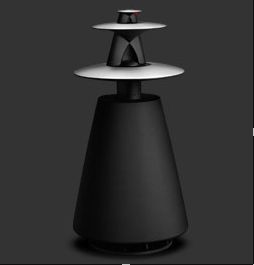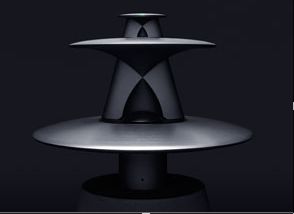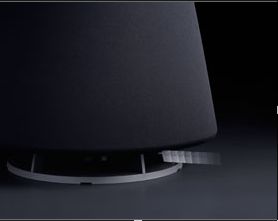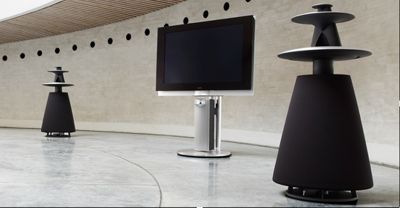|
|
||||
It's about the technology…
Bang & Olufsen is well known for making quality equipment that looks as interesting as it sounds, and the BeoLab 5's are no different. They look kind of like Doctor Who Daleks (B&O is hoping to "exterminate" the competition, perhaps?) or gigantic, 120 pound salt and pepper shakers. They'll certainly make a statement in the listening room – but what's important isn't how they look but how they sound, especially when you're talking about speakers that cost more than the first house my wife and I bought some (mumble mumble) years ago.
The major keys (no musical pun intended) to the BeoLab 5's are their built in ICEpower modules, Acoustic Lens Technology and Adaptive Bass Control.
 I'm familiar with ICEpower (ICE stands for Intelligent, Compact, Efficient) thanks to my work with Rotel, who use ICEpower modules in several of their amplifiers including the 500 watt per channel "Class D" RB-1092's and RB-1091 I use currently as my reference amps. I don't really understand how the technology works, but the results are prodigious power, low heat and marvelous audio quality from relatively small sizes (so much so that the three amps I use currently take up the same space as the one amp I used before, while putting out 2.5 times the power and sounding better).
I'm familiar with ICEpower (ICE stands for Intelligent, Compact, Efficient) thanks to my work with Rotel, who use ICEpower modules in several of their amplifiers including the 500 watt per channel "Class D" RB-1092's and RB-1091 I use currently as my reference amps. I don't really understand how the technology works, but the results are prodigious power, low heat and marvelous audio quality from relatively small sizes (so much so that the three amps I use currently take up the same space as the one amp I used before, while putting out 2.5 times the power and sounding better).
B&O builds the ICEpower right into the BeoLab 5's, with 250 watt modules powering the tweeter and midrange drivers and each of the two bass drivers being treated to 1000 watt modules. That's 2500 watts of power per BeoLab 5, in case you weren't keeping track – as much power in one "channel" as I have in all five main channels of my home theater.
That kind of oomph is important for more than just playing music loudly, though of course it also allows that with gratifying results. It also gives you plenty of "punch", which I notice particularly with percussion. I'm often struck (no musical pun intended here, either) by the way drumsticks on skins and other percussion instruments sound via ICEpower amplification, and the BeoLabs came through here in spades as well, the demo also featuring a percussion piece that filled the little jazz club with a rhythm section that sounded as if it were there.
I need to get my own copy of that track (from a O-Zone Percussion Group CD) for when I'm testing audio systems…
 Acoustic Lens Technology and Adaptive Bass Control are Bang & Olufsen's "magic bullet," an attempt to eliminate the "sweet spot" in the listening room, the place where the speakers' sound and separation is optimal – or the reason why my listening chair is located exactly where my front speakers aim, and everyone else who visits can darn well sit somewhere else.
Acoustic Lens Technology and Adaptive Bass Control are Bang & Olufsen's "magic bullet," an attempt to eliminate the "sweet spot" in the listening room, the place where the speakers' sound and separation is optimal – or the reason why my listening chair is located exactly where my front speakers aim, and everyone else who visits can darn well sit somewhere else.
B&O says its Acoustic Lens Technology distributes the sound from the midrange and high frequency drivers 180 degrees horizontally in front of the loudspeaker, which they say allows the listeners to move around or sit outside the traditional sweet spot. They say it also offers a constant tonal balance from direct and reflected sound, minimizes sound reflection from floors and ceilings, and gives an improved sense of space and realism.
The lenses also give the BeoLab 5's their unique, Dalek-ish, appearance.
The company says the key benefit of Adaptive Bass Control is "unrestricted placement of the individual loudspeaker in any room, regardless of shape, size and material, while clarity and timbre is not degraded". When combined with the Acoustic Lens Technology, this (at least in theory) should eliminate the sweet spot and allow "asymmetric positioning" of the speakers, which means you could put one BeoLab 5 in a corner of the room, and leave the other free standing or near the middle of a wall. This could make the BeoLabs popular for people who'd rather have a room with speakers in it than to require that a room be set up for speakers.
 It seems to work, too, at least as witnessed in the demo. Sound doesn't appear to be coming from the speakers at all, rather it's just there. Naturally, I'll have to test this in my own listening room before I'm convinced totally, but it was a heckuva demo.
It seems to work, too, at least as witnessed in the demo. Sound doesn't appear to be coming from the speakers at all, rather it's just there. Naturally, I'll have to test this in my own listening room before I'm convinced totally, but it was a heckuva demo.
Watching the Adaptive Bass Control at work is pretty cool. Press a button on the top of the BeoLab 5 and a little microphone-like thing emerges from its bottom and the speaker "identifies itself as part of the acoustic environment", figuring out where it is in the room and adapting itself accordingly.
According to Bang & Olufsen, the ABC is calibrating for deep bass 20-300Hz , creating a Bass equalization to compensate for room boundary effects that influence the Deep Bass performance adversely. This means you can place the 5's wherever you want without affecting their bass performance, even if one speaker is in a corner and one isn't.
It's a two step process, with the microphone/sensor thingy moving out farther as the calibration continues. The visual effect made me wonder if the BeoLab 5 had a microphone in its base or if it was just happy to see us.
Getting rid of the sweet spot has been a Holy Grail of audio for years, and is why speaker placement has been so important traditionally.
I didn't have a good chance to test the sweet spot theory at the demo, since I had positioned myself where the sweet spot would have been anyway, but the whole club was filled with music as if the band were there in person, the speakers completely invisible sonically.
And since the BeoLab 5's are self powered, you don't need a separate amplifier to run them. In fact, I was told you can hook an iPod or similar device into it directly and go from there, though I daresay that anyone who shells out for these speakers wouldn't be prone to inflicting dumbed down MP3 files onto them.
The experience …
The jazz club demo featured Snake Davis on sax and B&O's Brendan Rothwell on bass, playing karaoke-like to a CD with the sax and bass tracks stripped out. Then they'd play us a full version with all tracks included to give us an A/B comparison. The sound was exquisite though, since the backing tracks were the same in both parts of the test, that part wasn't much of a test.
The actual challenge of discerning the live sax and bass tracks from the "Memorex moments" was a tad stacked, too, though I don't suspect any evil intent here. But Davis admitted up front that he was playing a different saxophone from the one in the recording, so no matter how good the BeoLabs were the live and recorded saxes weren't going to sound exactly the same. And since I imagine the CD wasn't recorded at the same venue as it was played in our demo, it would be tough to recreate the exact sound anyway.
A better test would have been to record the entire band playing live as we listened to them, and then play back the same recording through the BeoLab 5's – especially if we were blindfolded for both parts of the test. Alas, that would have been much more challenging logistically, and I doubt it would have been feasible for our rather intimate demonstration.
One other regret is that I didn't get to listen to any of my own music, though I'm confident they'd have allowed it if I'd had the foresight to bring some.
But all caveats aside, the BeoLabs presented both the live and the canned performances gloriously, enough to convince me they are very special loudspeakers (as they should be!). I have to try them in my home theater, if even just for a short review period.
Except that I know what'll happen: I won't want them to leave and that divorce question will rear its ugly head again.
Copyright 2008 Jim Bray
Jim Bray's columns are available through the TechnoFile Syndicate.

 The Big Bang & Olufsen Theory – Flagship Speakers Boast Huge Power, Great Sound
The Big Bang & Olufsen Theory – Flagship Speakers Boast Huge Power, Great Sound 